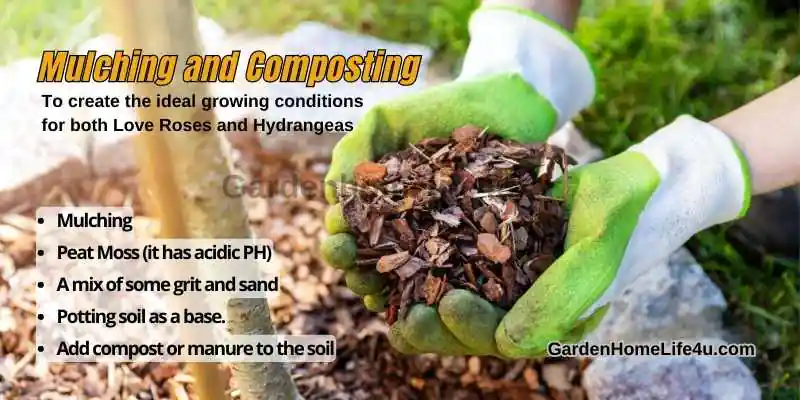Hydrangeas and roses are some of the most popular and beloved plants in the world. They’re known for their vibrant colors, sweet fragrances, and timeless beauty. However, taking proper care of these plants can be a bit of a challenge, especially if you’re new to gardening. There are a few important dos and don’ts that you need to keep in mind if you want to keep your hydrangeas and roses thriving. From proper watering and fertilization to pruning and pest control, there are many factors that can impact the health of your plants. In this article, we’ll explore the top dos and don’ts of hydrangea and rose care, so you can enjoy a beautiful garden all year round. So, whether you’re a seasoned gardener or just starting out, read on to learn how to keep your hydrangeas and roses healthy and vibrant.
Whether you’re looking to add some vibrant color or lush texture to your outdoor space, Love Roses and Hydrangeas can be wonderful additions. With proper maintenance, they can thrive and render your garden stunning beauty and landscape. Here are some tips on how to care for these flowers. On a quick note, we have tailored this content based on the conditions and types of plants most available in the UK however the information presented is generally applicable in most situations and you may use the information as you wish and as applicable in your particular region or place.
Roses and hydrangeas have different needs. 
The first thing to note about hydrangeas is that they are much more tolerant of poor soil and dry conditions than roses. Hydrangeas also generally need less sun than roses. They rather prefer indirect sunlight and direct scorching sun on them throughout the day may be harmful to Hydrangeas.
On similar notes, Hydrangeas are also equivalent if not more susceptible to pests than roses—especially aphids, which love their sweet nectar! Aphids don’t present any immediate danger to the plant itself, but they’ll shorten its lifespan by weakening its health over time. If you notice white powder on the leaves or buds of your hydrangea, this means there are aphids present on your plant
Why Even Compare Roses and Hydrangeas?
As suggested in the above section, they have some differences in the requirement and needs however if you can get the soil bed right, and more sun-tolerant Hydrangeas, they will look stunning together! They both tend to flower late into the autumn season and will give you a chance to thoroughly enjoy the flowering, colour and bloom late in the season. We personally love growing them together if possible at all using the appropriate selection of species but if not they will still go very well in their own spaces and will complement each other.
Select the Right Location 
When choosing a place to plant Love Roses and Hydrangeas, consider the amount of sunlight, shade, moisture levels, and soil type.
If planting separately,
- For Roses, pick an area with four to five hours of direct sunlight each day.
- for Hydrangeas choose an area receiving throughout the day, indirect light and possibly some direct sun.
if planting together then pick the right type of sun-loving Hydrangeas.
Soils should be loamy and rich in organic matter with good drainage. Both plants will require supplemental watering during dry periods. The soil should be amended with compost or other organic matter to improve fertility and drainage. The pH should be slightly acidic, between 6.0 and 7.0.
Hydrangeas bloom can be dominated by the pH of the soil, with acidic soil resulting in blue blooms and alkaline soil in pink blooms, or even a mix of both.
It is important to avoid over-watering as this can lead to root decay and other issues. Hydrangeas also don’t prefer windy areas and like to be in corners sheltered from heavy wind.
- Drainage is of utmost importance.
- Stay well away from windy places.
If the soil is too wet, it should be mixed with sand or gravel to improve drainage. Additionally, both plants will benefit from regular fertilization to ensure they are getting the nutrients they need. It is also important to monitor the soil moisture levels and adjust watering accordingly.
Popular Types of the Hydrangeas in the UK
- Hydrangea arborescens: A low-maintenance shrub with large, dome-shaped blooms in white and light green, ideal for shady as well as sunny areas.
- Hydrangea serrata: This type of hydrangea has delicate, lacecap blooms in shades of blue, pink, and white, and is well suited for partial sun.
- Hydrangea quercifolia: Also known as the oakleaf hydrangea, this native to the UK has distinctive oak-shaped leaves and large clusters of white blooms in the summer.
Sun-Loving Hydrangeas if you prefer
if you do prefer to go for Hydrangeas and roses together, you might want to consider sun-loving types of hydrangeas.
- Paniculata Hydrangea: A tall and slender shrub with cone-shaped blooms that come in white, pink, and green shades.
- Macrophylla Hydrangea: This type of hydrangea has large, round blooms in shades of pink, blue, purple, and white.
- Oakleaf Hydrangea: A native to the UK, oakleaf hydrangea has distinctive oak-shaped leaves and large clusters of white blooms in the summer.
- Arborescens Hydrangea: A low-maintenance shrub with large, dome-shaped blooms in white and light green. it will tolerate the sun but needs to be shaded on the warmest of days.
Utilizing Mulching and Composting to Improve Soil Quality. 
To create the ideal growing conditions for both Love Roses and Hydrangeas, Use
- Mulching
- Peat Moss (it has acidic PH)
- A mix of some grit and sand
- Potting soil as a base.
- Add compost or manure to the soil
Roses are susceptible to many common fungal and bacterial pathogens.
Roses are susceptible to many common fungal and bacterial pathogens.
- Rose blight
- powdery mildew
- black spot
- Rose dieback
- Root Rust
- Many others.
- A healthier rose offers more resistance to sickness, that’s your first line of defence.
- Use fungicides and specialized pest spray to treat the sick plant.
- Fungicides are available in several forms, including liquids and powders.
- Certain fungicides may affect bees so it’s best to avoid treating them during the blooming period.
- There are also some more resistant variants of rose which offer more resistance to pathogens.
- Remove the infected part from plants as soon as and destroy it, don’t throw it away in the bush again!
Home Remedy for Aphids and Spider Mites
Roses and Hydrangeas can be inundated with common pests such as aphids and spider mites. To prevent an infestation, spray the foliage with a combination of liquid soap, garlic, and water. This mixture will act as a natural insect repellent and help to keep pests away.
- Regular inspection of your plants is the key.
- Nothing can replace personal care and love for your plants!
Roses should be pruned each year. 
Pruning is a key step to maximising the growth and health of your Roses and Hydrangeas. To initiate new growth and encourage flowering, prune back plant stems by one-third in very early spring, before new growth begins. Pruning should be done to shape and remove dead or diseased wood and to promote new growth.
Pruning should be done with sharp, clean pruners to ensure a clean cut. Be sure to remove any dead or diseased stems as well.
Make sure to trim off the Rosehips of the rose plants. Rosehips are the fruit of rose plants, and they should be removed from the plant to help promote healthy growth. Trimming off the rosehips will also help to prevent disease and pests from attacking the plant.
The most important thing you need to know when pruning any plant or bush is over punning will weaken the plant and make it less resistant to pests, disease, and weather conditions.
Roses require six to eight hours of sun per day.
Roses require six to eight hours of sun per day. This is important for the plant’s growth and blooming. In fact, the more sunlight your roses get, the more likely they are to bloom with a more vibrant colour!
Make sure your roses aren’t planted too deep in the soil.
When you plant your roses, make sure that you do not bury them too deep in the soil. Ideally, you are looking at just below soil level. Plant them too deep and your lovely roses will suffer!
Feed your rose bush throughout the growing season.
Feed your rose bush throughout the growing season. If you choose not to use any supplemental feeding, be sure to add an organic fertilizer formulated for acid-loving plants such as coffee grounds, composted leaf mould, or eggshells can be an interesting addition to your organic fertiliser collection.
Locations for Hydrangeas – Part Shady Part Sunny
Hydrangeas need at least 2-3 hours of morning sun and afternoon shade each day.
Hydrangeas should also be planted in a cool and moist location, but not too wet..
Applying Mulch to retain moisture and protect roots
To ensure that the hydrangea/Rose plant roots don’t lose too much water on hot summer days, apply a thick layer of mulch 1 to 3 inches deep around the plants.
You can choose from organic or inorganic materials.
- Compost
- Bark shavings
- Wood chippings
- Pine needles
- Straw
One interesting material which we have personally used is
- Ornamental gravel of suitable stone size ( 20 to 30 mm).
- It is heavy, doesn’t get dispersed easily, and discourages the weeds effectively.
We hope by using some of the techniques described above you will be able to enjoy these wonderful flowers throughout the summer season!
FAQ: Care for Roses and Hydrangeas
Is Rose Bush a potential Starter gardening project?
Planting a rose bush can be a great gardening project for beginners. However, it’s important to note that while roses are beautiful and rewarding plants, they do require some special care and attention to thrive. Here are some important points to note before you pick a Rose bush starter project for the coming season. There are many different types of roses, and some are easier to grow than others. Look for varieties that are disease-resistant and low-maintenance, such as shrub roses or landscape roses. Roses need consistent watering and feeding to grow strong and healthy. They also require constant lookout and care against bug and fungus attacks, they are prone to it. Roses need plenty of sunlight (at least 8 to 6 hours a day) and well-draining soil and should be planted in the spring or fall when the weather is mild and there is plenty of moisture in the soil. Pruning and deadheading (removing spent blooms) are important for keeping your rose bush healthy and promoting new growth.
What variety of Rose bush is easier to plant for starter gardening?
Ultimately, the best type of rose bush for a beginner gardener will depend on factors such as climate, available space, and personal preferences. Researching and choosing a variety that suits your needs can help ensure a successful gardening experience. Below are some varieties which can be favored by starter gardeners.
- Grandiflora Roses: These roses are a cross between hybrid teas and floribundas and are known for their large, showy blooms.
- Knock-Out Roses: These are popular low-maintenance roses that are disease-resistant, hardy, and bloom prolifically throughout the growing season.
- Shrub Roses: These are hardy and disease-resistant roses that require minimal pruning and care. They also come in a wide range of colors and sizes.
- Floribunda Roses: These are popular for their clusters of blooms and relatively low-maintenance care. They are also more disease-resistant than some other types of roses.
What is the most important thing about planting successful hydrangeas?
One of the most important things to consider when planting hydrangeas is the location and partial sunlight. Hydrangeas prefer a site with morning sun and afternoon shade, as they do not like to be in direct sunlight for extended periods of time. Also, They also require well-draining soil that is rich in organic matter.

